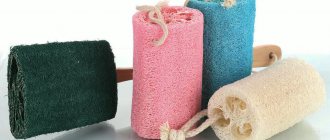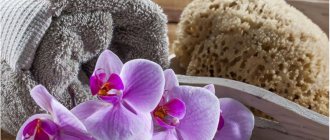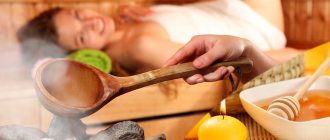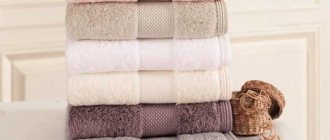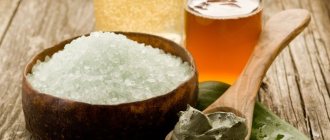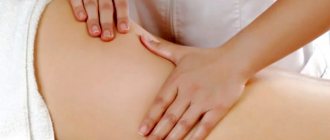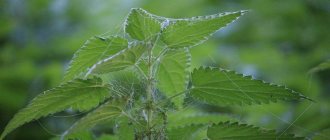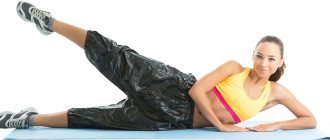Let's choose the right washcloth together!
Foam sponges
Delicate and soft, giving abundant foam. Of course, they cannot thoroughly wash the body due to their structure, but there are also combined options.
Flaws:
- They turn sour quickly (if you don’t dry them in time).
- They quickly lose their presentation (tear).
- Too bright foam “bunnies” and “fruits” can cause allergies.
Polyethylene sponges
The most ideal option for rough skin. Most often they are used by the strong half of humanity.
Typically, such washcloths are made quite long and have handles attached to both sides - for comfortable washing of the back.
Flaws:
- Too rough (not suitable for sensitive and delicate skin).
- The quality, as a rule, leaves much to be desired.
Rose sponges
Also made from polyethylene. Small in size, lightweight and travel-friendly, very quick-drying and inexpensive - they have become very popular in Russian bathrooms.
Flaws:
- They quickly lose their presentation (unwind, tear at the base). Perhaps this is their only drawback.
Washcloths-towels
They were invented back in the distant 60s by enterprising Japanese. The washcloth is a “canvas” of specially woven nylon threads.
Pros:
- Strong and durable.
- Various hardness (you can choose to suit your skin).
- They have special additives in the composition for gommage.
- Convenient to wash (any part of the body is accessible to them).
- Massage effect.
The washcloth has one drawback - its large size.
Criterias of choice
Having figured out how, it turns out, to use such a familiar object correctly, let’s move on to the main selection criteria.
Material
A bathroom accessory can be of natural or artificial origin. Each type has its pros and cons.
Natural
| Advantages | Flaws |
| Hypoallergenic. The exception is the sea sponge. It contains iodine, which can cause severe irritation to the skin. | They take a long time to dry. |
| Safe for the environment. They rot quickly and, unlike synthetic analogues, do not require processing. | They are short-lived and quickly deteriorate. |
| There are different degrees of hardness: from soft, giving only foam, to scrubbing and anti-cellulite. | |
| Suitable for massage. | |
| Lets air through. | |
| At high temperatures they do not emit toxic substances. |
Let's look at the most common materials on the market for creating a washcloth.
- Hemp
These are fibers from the stems of industrial hemp. Durable, rough to the touch.
| pros | Minuses |
| It lasts a long time. | Very hard, can leave scratches on the skin. |
| Foams well. | |
| Resistant to water, even salty. | |
| Suitable for lymphatic drainage massage. | |
| It tightens the skin well, making it elastic. | |
| Helps get rid of cellulite. |
- Loofah
A product made from the dried fruits of a plant called “mad cucumber”.
| pros | Minuses |
| Durable. | Before bathing, soak for 15-20 minutes in hot water. |
| Durable. | Rude. |
| Provides high-quality, deep cleansing of the skin. | Not suitable for children, as well as those with problematic or delicate, sensitive skin. |
| Helps fight orange peel. | |
| Pronounced lymphatic drainage effect. |
- Lyko
The washcloth is knitted only from young, thin and very soft linden bark.
| pros | Minuses |
| Suitable for children. | It takes a long time to dry. |
| Does not harm sensitive skin. | It quickly falls apart into small pieces and can clog the drain. It is better to use in a bath. |
| Natural antiseptic. | Sold in few places. |
| Anti-acne effect. | Doesn't foam well. |
| Heals wounds. | Rarely found. |
- Birch bark
Similar to the bast version, birch is made from young, soft parts of birch bark.
| pros | Minuses |
| Durable, moisture resistant. | Price. |
| Pleasant aroma. | Rarely goes on sale. |
| Suitable for children. | |
| Does not harm sensitive skin. | |
| Durable. | |
| Has antiseptic and anti-inflammatory properties. | |
| Has a massage effect. | |
| Deeply cleanses pores and successfully eliminates acne. | |
| Helps in the fight against orange peel. |
- Linen
Strong tapes, gloves or mittens made of linen fabric rid the body of small irregularities and peeling, making the skin silky and soft.
| pros | Minuses |
| It lasts a long time. | No. |
| Durable material. | |
| Gives abundant foam. | |
| Absorbs water well. | |
| Does not cause allergies. | |
| Soft scrubbing effect. | |
| Light massage function. | |
| Stimulates blood microcirculation. |
- Sisal
These super-stiff washcloths (usually gloves or mittens) are woven from the strong fibers of agave leaves.
| pros | Minuses |
| Durable. | Produces little foam. |
| Tones and tightens the skin. | It needs to be soaked in boiling water for a long time. |
| Relieves swelling. | |
| Helps against orange peel. |
- sea sponge
Tender, delicate and pleasant sponges are made from marine animals of the Spongia officinalis, Hippospongia communis families.
| pros | Minuses |
| Suitable for children. | They quickly become unusable. |
| Soft. | They are expensive. |
| Forms abundant foam. | Hardens after drying. |
| Suitable for sensitive, problem skin. | |
| Antibacterial effect. |
Synthetic
These washcloths are made from a variety of materials - foam rubber, polyester, rubber, polyethylene threads, as well as other artificial materials. There are various shapes, textures, hardness and colors.
We list the main advantages and disadvantages of synthetic washcloths.
| pros | Minuses |
| Suitable for children. | They quickly become unusable. |
| Soft. | They are expensive. |
| Forms abundant foam. | Hardens after drying. |
| Suitable for sensitive, problem skin. | |
| Antibacterial effect. |
Now let's look at the characteristics of the most common types of synthetic washcloths.
- Foam sponge
One of the most popular bathroom accessories that can be found in any supermarket.
| pros | Minuses |
| Variety of shapes, colors, sizes. | They quickly deteriorate, crumble, tear. |
| There are specimens of any hardness. | They take a long time to dry. |
| Gives abundant foam. | Bright, flashy sponges painted with low-quality dyes can cause allergies. |
| There are combined options - one side is hard, the other is soft. |
- Rose sponges
Cute polyethylene flowers have earned their popularity for both their attractive appearance and functionality.
| pros | Minuses |
| Inexpensive. | They easily lose their original shape - they unwind and tear. |
| Lungs. | They don't scrub. |
| They take up little space and can be taken on trips. | They don't massage. |
| They foam well. | |
| Dries quickly. | |
| Do not injure the skin. |
- Washcloths-towels
Invented in the 60s of the 20th century in Japan, they gained wide popularity throughout the world. The product is a wide towel made of durable nylon threads. Now Japanese towels are sold both on online platforms and in regular stores like FixPrice.
| pros | Minuses |
| Comfortable. | Beginners may find it awkward at first. |
| There is an opportunity to choose according to your skin type - there are both hard and soft. | |
| Durable. | |
| Durable. | |
| Soft peeling effect. | |
| Light massage effect. | |
| They have special additives in the composition for gommage. |
- Polyethylene scouring tapes
An extreme peeling option for normal skin, but excellent for rough skin.
| pros | Minuses |
| Convenient shape. They often come with handles or laces. | They are rarely of high quality and tear quickly. |
| Rough. |
Rigidity
According to the degree of rigidity, all products are divided into five types:
- Soft;
- Average;
- Hard;
- Super hard;
- Combined.
Firmness depends on your skin type. If you are not sure about the choice, take a soft or combined option. This way you are less likely to injure your skin.
Shape, color
The color of the washcloth and its shape are also important when bathing.
For example, bright, cheerful sponges in the shape of animals are perfect for washing those kids who do not like or are afraid to bathe. A soft washcloth-mitten made of flannel or terry cloth will speed up the washing of children up to one year old.
Size matters and depends on what parts of the body you want to wash. And also your habits and health. Small models are good for local hygiene and massage procedures. For example, a small sponge is enough to cleanse or scrub your face. Anti-cellulite sponges are also usually small and easily fit into the palm of your hand.
On the contrary, large models in the form of ribbons, towels, and braids allow you to quickly wash all parts of the body without showing miracles of flexibility and without the risk of slipping. This feature makes these washcloths convenient for elderly or limited mobility people.
All kinds of loops, laces, and handles significantly increase the ergonomics of the product - it will not slip out of your hands or get lost under water, and you do not need to bend over to get it. In addition, a washcloth suspended by a loop dries faster.
From loofah
A product from a plant called "crazy cucumber".
- Perfectly and deeply cleanses the skin.
- Has massage and exfoliating properties.
- Has an anti-cellulite effect.
- Accelerates the process of cell regeneration.
- It serves for a long time and has increased strength.
Flaws:
- Rough (not suitable for sensitive skin).
- Requires softening (usually it is simply soaked in hot water 15 minutes before the bath).
Contraindications
Despite the apparent “harmlessness”, using a regular washcloth is fraught with a lot of dangers. The list of contraindications for use contains the following:
- Sensitive skin;
- Dermatological diseases;
- Large moles, papillomas on the body;
- Blood diseases;
- Phlebeurysm;
- Damage to the skin;
- Hypertension;
- Cardiovascular diseases;
- Oncological diseases;
- Acute inflammatory diseases;
- Pregnancy.
The rougher the product, the more carefully it needs to be used.
Made from sisal
Many people have heard about the fiber obtained from agave leaves. As a rule, such washcloths are cute woven mittens.
Among the advantages are:
- Pronounced anti-cellulite effect.
- Peeling properties and acceleration of blood circulation.
- Long service life.
There are many more disadvantages:
- Increased rigidity (too rough washcloth). It is not recommended to use it more than twice a week. And for people with an abundance of moles and sensitive skin, it is better to abandon it altogether in favor of a softer washcloth.
- Low foaming.
- Requires soaking in hot water.
- High price.
Dry massage brush
It can not only replace the usual washcloth, but also significantly improve the quality of the skin. Some people use a brush for self-massage in the shower, others without using water.
If we talk specifically about replacing a washcloth with this brush, then there is a simple ritual:
- Steam your body under hot water
- Apply soap or gel to the body
- Use the brush on each leg first. From bottom to top, applying a little force, but without causing discomfort to the skin. Especially “work out” the hips and buttocks. This improves blood circulation and removes excess fluid from the body. Some people even manage to get rid of cellulite this way.
- Then move on to your hands. Also from the hands to the shoulders, from bottom to top.
You can and should use a brush for self-massage constantly, two to four times a week. It costs approximately 1,000 rubles. It is made from different materials, but it is better to buy one with natural bristles and a wooden handle.
From the bast
This bathhouse “masterpiece of naturalism” is made from the subcortical linden layer. It is generally accepted that such a washcloth is the most beneficial for the skin of all existing natural ones.
Pros:
- Deep cleansing of pores.
- Destruction of microbes (note – release of phytoncides during the washing process).
- Exfoliating pronounced effect.
- Low cost.
- Medium hardness and softening in water.
Flaws:
- Short lifespan (the washcloth begins to crumble).
Sea sponges
Very soft, delicate and pleasant to the body - with a porous soft structure. They foam well and do not cause skin irritation or allergies.
They can be easily used on baby skin or to cleanse delicate facial skin.
But there are also disadvantages:
- Very short life span.
- Very high cost.
- Hardens after drying.
- Requires replacement every 2-3 months.
Of course, these are not all washcloths. There are also examples for hamam, eco-scrubbers made of cellulose, and so on. The variety is great, and the choice is limited only by wishes and wallet size.
Natural
Washcloths made from natural materials have a wide range of advantages.
Read also: Gearbox and everything you need to know about it
First of all, the advantages of the products include:
- Safety . Natural materials do not cause allergies or irritation. They are suitable for both adults and children. Exception: sea sponge-based washcloths can cause severe irritation due to the high iodine content in the composition.
- Environmental friendliness . After the product has served its useful life, it can be disposed of with normal household waste.
- Wide choose . Depending on the material, a natural washcloth can be either hard or soft. This allows you to choose an option for any skin type.
- No toxic substances in the composition . When exposed to high temperatures, steam and hot water, natural materials do not release potentially dangerous compounds into the air.
Despite their advantages, such washcloths have minor disadvantages:
- Limited service life . Natural materials quickly deteriorate and lose their shape. A natural product should be changed every 2-3 months (although much depends on the frequency of use).
- Long drying time . These washcloths take quite a long time to dry.
- Tendency to form mold and mildew . If you do not dry the product well and store it in a humid environment, fungus and mold will soon form in the fibers. Using such a washcloth will become dangerous.
Rules for using a washcloth for washing and caring for the body
Even children know that a washcloth, like a comb or toothbrush, is unique . And, of course, the rules of care apply to it to the same extent as to other personal items.
- We change the washcloth every 2-5 months, in accordance with the material. The artificial one can be changed less often, the natural one – regularly!
- After the washing procedure, be sure to thoroughly rinse the washcloth and dry it equally thoroughly.
- 1-2 times a week we treat the washcloth with antiseptic agents or soak it in boiling water, if the material allows. You can use a solution of boiling water and vinegar.
- We keep washcloths away from the sun and batteries (we extend their service life).
- We don’t use hard washcloths every day! The scrubbing effect can become a real headache if you use them more than once a week. Like scrub masks, these washcloths are recommended to be used 4-5 times a month so as not to cause irritation and inflammation of the skin.
- Do not twist the washcloths when spinning (they will lose their shape and appearance)!
- If the material allows, once a week you can wash the washcloth in the washing machine with other things.
Foam rubber, luffa, sisal
What materials are washcloths made from and what distinguishes them from each other?
Luffa is a tropical vine of the Cucurbitaceae family. A washcloth made from its fruits has a relatively mild exfoliating and massage effect; you can wash with it every day. After purchasing such a washcloth, you need to steam it in boiling water for about 15 minutes, then it will become softer.
Sisal is a fiber from the leaves of the Mexican agave plant, a very tough material. Washcloths made from it perfectly massage the skin, improve blood and lymph circulation, “awakening” the body. However, you cannot use it more than 1-2 times a week. Sisal fibers fray very quickly, so this type of washcloth will not last long.
Ramie (Asian nettle), on the other hand, is a very strong fiber that is resistant to twisting, stretching, tearing, and rotting. Excellent washcloths in the form of mittens and long strips are made from it. Ramie washcloths knitted in stocking stitch are softer, while bouclé ones are stiffer. Both of them cope well with all their responsibilities.
Bast (linden, birch) is the inner layer of the bark of a young tree. Bast washcloths (linden - softer, birch - harder) are suitable for daily use. New, they have an antibacterial effect, since bast contains a lot of phytoncides that are released during the washing process. Their main drawback is that they become unusable very quickly.
Foamed cellulose (viscose) is a relatively soft material. Washcloths made from it are recommended for people with problematic and sensitive skin; they have a mild exfoliating effect and are great for daily use. In addition, they foam detergent well and absorb large amounts of water.
Natural sea sponge is at least an order of magnitude more expensive than artificial ones. For the body, there is little point in buying it, and given its fragility, such a purchase will simply be an empty transfer of funds. But the sea sponge is good as a sponge for facial care.
Foam rubber is not the best choice. This type of washcloth holds water well and foams soap, but it won’t really scrub the skin “squeaky clean.”
Polypropylene. The most common are handicraft braids, knitted from thin polypropylene ribbons. They are quite tough, good for soapy anti-cellulite massage of the thighs and buttocks, but it is better not to scrub more delicate skin with them.
Nylon. This material is abrasion-resistant, elastic, pleasant to the body, and exfoliates dead skin particles well. Washcloths made from it foam well for shower gel or soap.
And, of course, it is recommended to have several washcloths for different purposes:
- For every day - a soft sea or synthetic sponge.
- For convenient back washing , use a loofah washcloth or a brush with a long handle.
- To combat cellulite and have a massage effect , use a hard washcloth. For example, from bast or ramie.
- For feet and elbows - a sisal washcloth.
How to take a contrast shower for weight loss correctly?
The site Colady.ru thanks you for your attention to the article! We will be very pleased if you share your opinion and reviews about the washcloths you like!
Where can I buy
You can buy a washcloth both in online stores and offline supermarkets or small outlets with cosmetics and household chemicals. The advantage of “live” stores is that you can touch the product and tactilely evaluate its hardness. But when buying online, you save a lot of time.
It is also easier to find washcloths made from unusual, rare materials via the Internet - on social networks, on thematic websites, and message boards. What should you pay attention to in this case? Look at the seller’s reputation, its rating, read reviews. Pay attention to how long the seller or business has been in business. Don't trust fly-by-nighters. Study product photos.
